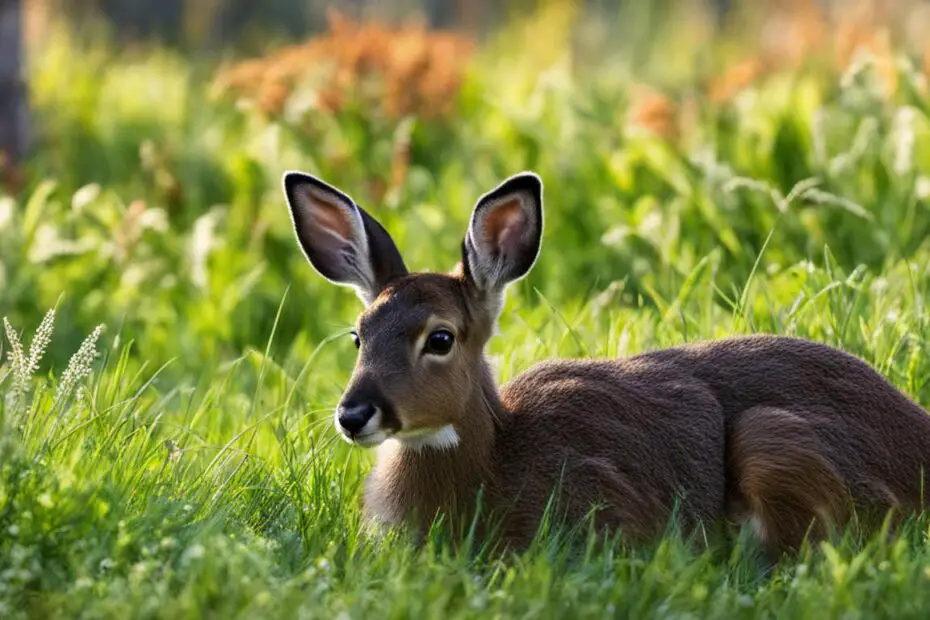When it comes to animal droppings, it’s important to be able to distinguish between different species. In this article, we’ll delve into the world of deer and rabbit poop, exploring the distinct differences in appearance, size, color, texture, quantity, location, odor, composition, nutrient content, and environmental impact. By understanding these variations, you’ll be able to accurately identify the droppings and gain insights into the animals that produce them.
Key Takeaways:
- Rabbit droppings are small, round pellets, while deer droppings appear as oval-shaped clumps.
- Rabbit poop is typically brown or black, while deer poop is dark brown or black.
- Rabbit droppings have a smooth surface with a shiny coating, while deer droppings have a rough surface.
- Rabbit droppings are usually found in clusters, while deer droppings are scattered in small quantities.
- Rabbit droppings have a mild earthy scent, while deer droppings have a pungent musky odor.
Appearance
Rabbit poop and deer poop have distinct differences in appearance. Rabbit droppings are characterized by small, round pellets, while deer droppings appear as oval-shaped clumps. The size of the droppings also differs, with rabbit poop measuring approximately 1/4 inch in diameter, while deer poop is about 1/2 inch in length.
Table 1: Comparison of Appearance
| Rabbit Poop | Deer Poop | |
|---|---|---|
| Shape | Small, round pellets | Oval-shaped clumps |
| Size | Approximately 1/4 inch in diameter | About 1/2 inch in length |
Understanding the appearance of deer and rabbit poop can help you differentiate between the two and gain valuable insights into the animals that produce them. By observing the shape and size of the droppings, you can make more accurate identifications in your outdoor adventures or animal tracking endeavors.
Differences in Color
One of the key distinguishing factors between deer and rabbit poop is the color. Rabbit droppings are typically brown or black, while deer droppings tend to be darker shades of brown or black. It’s important to note that color variations can occur depending on the diet of the animal. If a rabbit consumes a diet rich in dried grass and hay, its droppings may have a golden tint.
Here is a visual representation of the differences in color:
| Rabbit Poop | Deer Poop |
|---|---|
| Brown or Black | Dark Brown or Black |
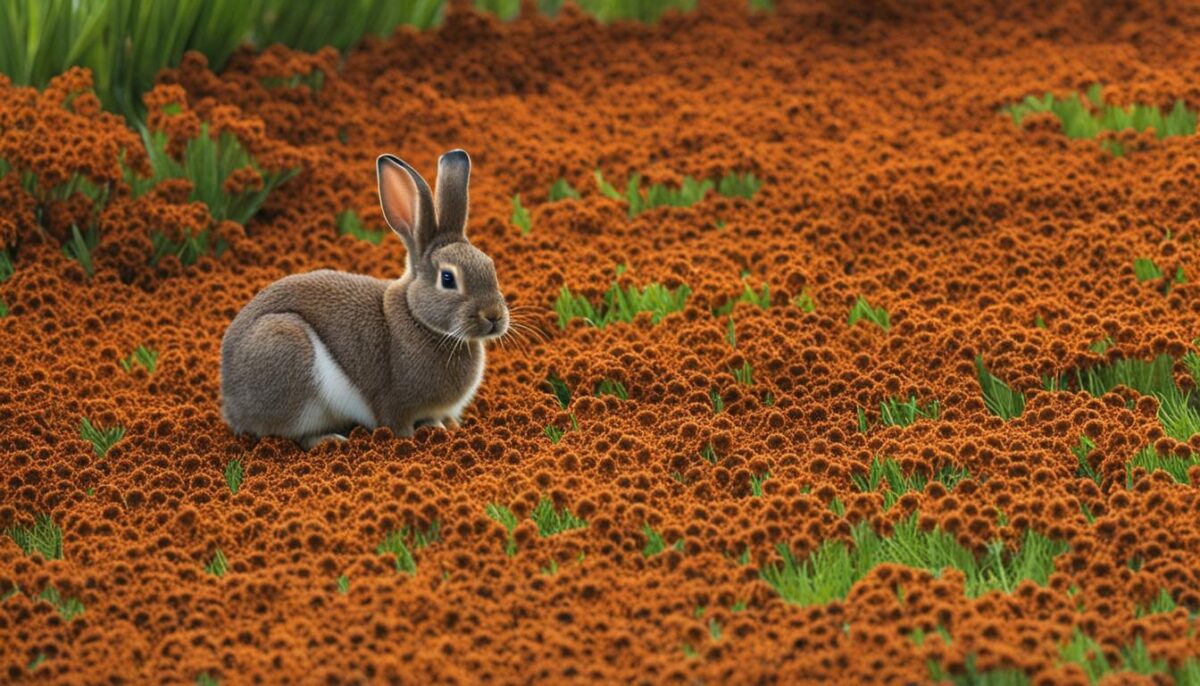 |
As you can see from the images, rabbit poop appears lighter in color compared to deer poop.
Next, we’ll explore the differences in texture between these two types of animal droppings.
Texture
To further analyze the differences between deer and rabbit droppings, it’s essential to consider their texture. Rabbit poop has a smooth surface with a shiny coating, giving it a distinct appearance. On the other hand, deer poop has a rougher texture, often containing remnants of plant material such as leaves or twigs.
This difference in texture can provide valuable insights into the feeding habits of these animals. The presence of plant material in deer droppings suggests that they primarily feed on vegetation, including leaves and twigs. In contrast, the smooth texture of rabbit droppings indicates a diet that consists mainly of softer plant material.
| Characteristics | Rabbit Poop | Deer Poop |
|---|---|---|
| Texture | Smooth with a shiny coating | Rough with remnants of plant material |
By closely examining the texture of animal droppings, you can gain a better understanding of their eating habits and the types of plants they consume. This information is helpful for wildlife enthusiasts, researchers, and those interested in tracking and identifying animal signs.
Visual Characteristics of Deer and Rabbit Feces
When it comes to identifying deer and rabbit feces, their visual characteristics play a crucial role. By closely observing the quantity, size, shape, and distribution of the droppings, you can gain valuable insights into these animals’ behavior and habitat preferences.
Deer Droppings: Deer droppings are typically scattered in small quantities. They appear as oval-shaped clumps and are approximately 1/2 inch in length. The droppings often contain remnants of plant material, such as leaves or twigs, which provide clues about the deer’s feeding habits.
Rabbit Droppings: On the other hand, rabbit droppings are usually found in groups or clusters. They are small, round pellets measuring about 1/4 inch in diameter. Rabbit poop has a smooth surface with a shiny coating and does not contain visible plant material.
Table: Visual Characteristics of Deer and Rabbit Feces
| Characteristics | Deer Droppings | Rabbit Droppings |
|---|---|---|
| Quantity | Scattered in small quantities | Found in groups or clusters |
| Size/Shape | Oval-shaped clumps, approximately 1/2 inch in length | Small, round pellets, approximately 1/4 inch in diameter |
| Visible Plant Material | Often contains remnants of leaves or twigs | Does not contain visible plant material |
By understanding these visual characteristics, you can accurately identify whether the droppings you come across belong to deer or rabbits. This knowledge can enhance your tracking skills and deepen your understanding of the wildlife in your area.
Location: Identifying Deer and Rabbit Scat
When it comes to identifying the scat of deer and rabbits, one important aspect to consider is the location where you find the droppings. Understanding the preferred habitats and behaviors of these animals can help you differentiate between their scat.
Rabbit droppings are commonly found near rabbit burrows, gardens, or lawns. These small, round pellets are often clustered together, indicating the presence of a rabbit population in the area. On the other hand, deer droppings are typically found near wooded areas or trails, as deer frequent these locations for feeding and shelter. The scattered distribution of deer scat suggests their tendency to move over larger areas.
By recognizing the specific locations where deer and rabbit scat is commonly found, you can gain valuable insights into the presence and movements of these animals. Whether you’re a wildlife enthusiast, a hunter, or simply curious about the wildlife in your surroundings, paying attention to the location of scat can provide clues to the presence and behavior of deer and rabbits.
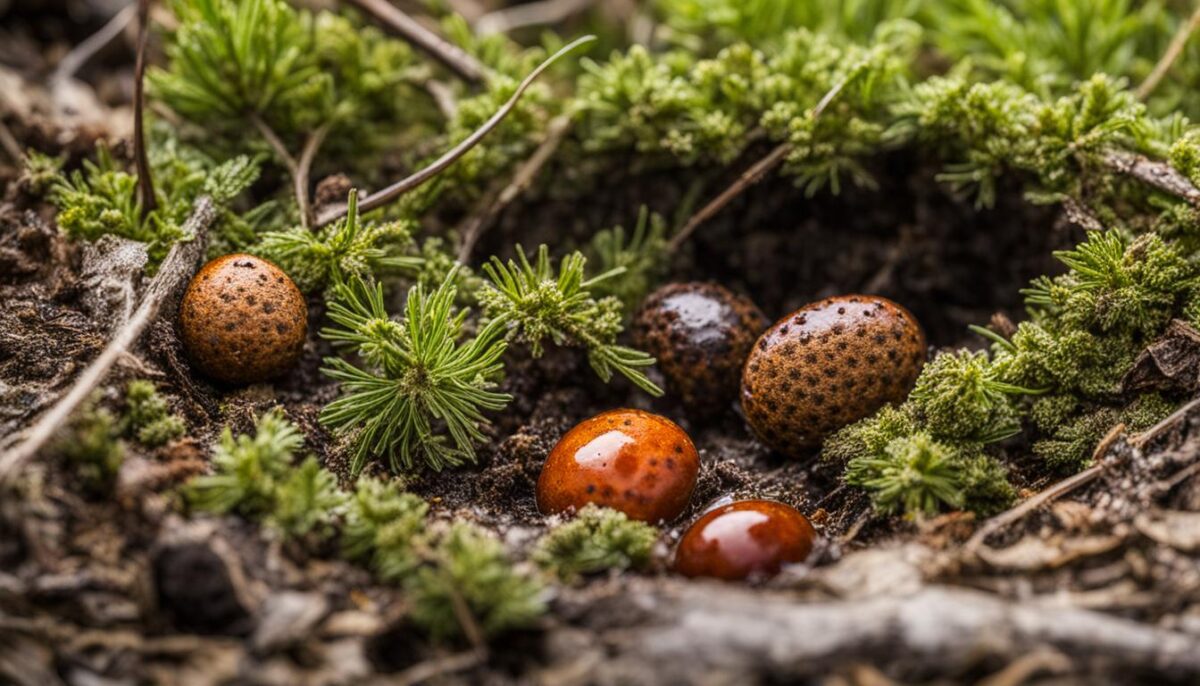
Differences in Location
To further illustrate the differences in location between deer and rabbit scat, let’s compare a few key characteristics:
| Rabbit Scat | Deer Scat | |
|---|---|---|
| Preferred Habitat | Near rabbit burrows, gardens, or lawns | Near wooded areas or trails |
| Grouping | Clusters or groups | Scattered |
As seen in the table above, rabbits tend to leave their scat in concentrated areas, typically close to their burrows or areas where they frequently feed. Deer, on the other hand, disperse their droppings more widely, making it less likely to find them in close proximity to one another.
By taking note of the specific locations where you come across scat and comparing it to the characteristics outlined above, you’ll be better equipped to identify whether you’re dealing with deer or rabbit droppings.
Distinguishing Deer and Rabbit Poop
When it comes to identifying animal droppings, the odor can play a significant role. Distinguishing between deer and rabbit poop based on their smell can provide valuable insights. Rabbit droppings typically emit a mild, earthy scent, while deer droppings have a pungent, musky odor.
Another key difference between the two is the composition. Rabbit poop consists mainly of plant material, while deer droppings contain a mix of plant material and browse, which are woody plant parts. These differences in composition reflect the varied feeding habits of these animals.
To further help differentiate deer and rabbit droppings, it’s important to consider their appearance and location. Rabbit poop is characterized by small, round pellets, while deer poop appears as oval-shaped clumps. Additionally, rabbit droppings are commonly found near rabbit burrows, gardens, or lawns, while deer droppings are often found near wooded areas or trails.
| Characteristic | Rabbit Poop | Deer Poop |
|---|---|---|
| Appearance | Small, round pellets | Oval-shaped clumps |
| Location | Near burrows, gardens, or lawns | Near wooded areas or trails |
| Odor | Mild, earthy scent | Pungent, musky odor |
| Composition | Mainly plant material | Plant material and browse |
By considering these distinguishing factors, you can accurately identify deer and rabbit droppings and gain a better understanding of the animals that produce them. So, next time you come across some animal scat, take a moment to analyze its odor, appearance, and location to determine whether it belongs to a deer or a rabbit.
Composition
Rabbit droppings consist mainly of plant material, while deer droppings contain a mix of plant material and browse (woody plant parts). These differences reflect the varied feeding habits of these animals. Deer, being herbivores, consume a wide range of vegetation including grass, leaves, twigs, and bark. This results in their droppings containing a mixture of plant components. On the other hand, rabbits primarily feed on grasses and leafy plants, hence their droppings consist mainly of these materials.
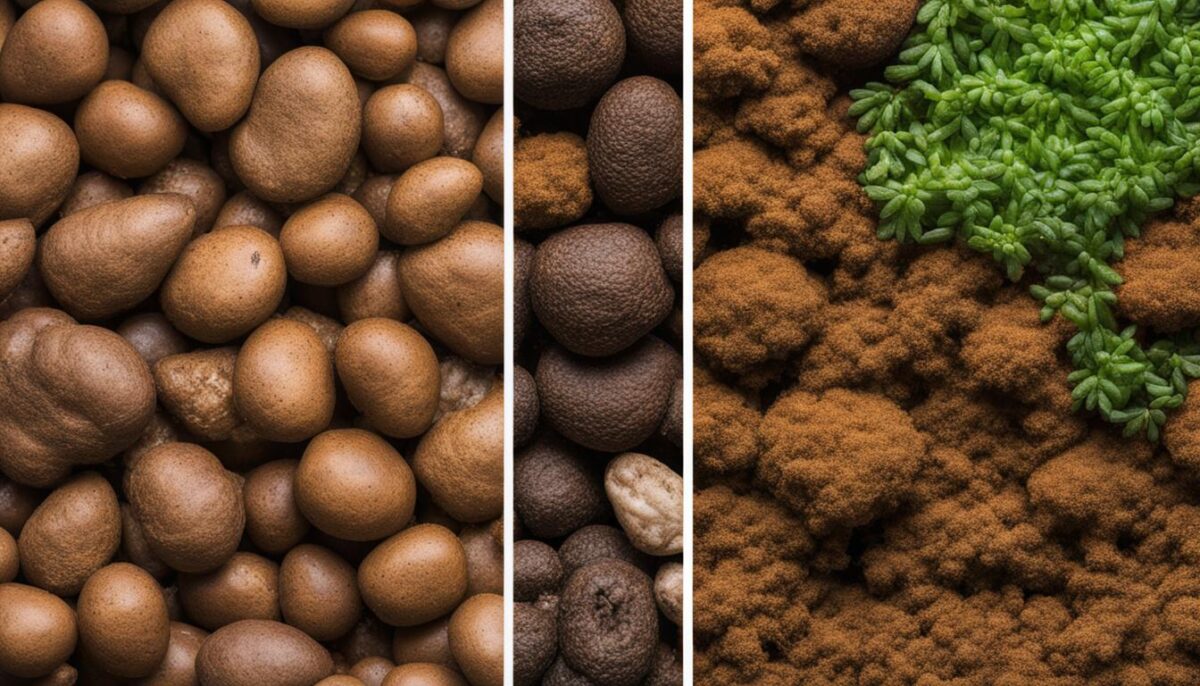
| Nutrient Content | Deer Poop | Rabbit Poop |
|---|---|---|
| Nitrogen | Moderate | High |
| Composition | Plant material and browse | Primarily plant material |
| Environmental Impact | Contributes to ecosystem balance and vegetation growth | Enhances soil fertility and acts as a natural fertilizer |
Analyzing Deer and Rabbit Droppings: Understanding environmental impact
When examining the droppings of deer and rabbits, it’s essential to consider their environmental impact. Both animal’s feces play a crucial role in nourishing the surrounding ecosystem. Rabbit droppings, for example, act as excellent natural fertilizers for plants and contribute to enriching the soil with their high nitrogen content. On the other hand, deer droppings contribute to seed dispersal and help maintain a balanced ecosystem.
By analyzing the environmental impact of deer and rabbit droppings, we gain a deeper understanding of how these animals contribute to their surroundings. Rabbit droppings, when used as fertilizer in gardens or natural habitats, promote healthy plant growth and provide valuable nutrients to the soil. However, it’s important to compost the droppings before using them to ensure proper decomposition and nutrient release.
“Rabbit droppings help fertilize plants and enrich the soil, while deer droppings play a role in seed dispersal and maintaining a balanced ecosystem.”
Understanding the different roles that deer and rabbits play in the environment through their droppings allows us to appreciate the intricate connections within ecosystems. From nourishing vegetation to supporting wildlife diversity, these small droppings have a significant impact on the delicate balance of nature.
| Deer Droppings | Rabbit Droppings | |
|---|---|---|
| Appearance | Oval-shaped clumps | Small, round pellets |
| Color | Dark brown or black | Brown or black, sometimes with a golden tint |
| Texture | Rough surface with plant material remnants | Smooth surface with a shiny coating |
| Quantity | Scattered in small quantities | Usually found in groups or clusters |
| Location | Near wooded areas or trails | Near burrows, gardens, or lawns |
| Odor | Pungent, musky | Mild, earthy |
| Composition | Plant material and browse | Primarily plant material |
| Nutrient Content | Contributing to soil and vegetation growth | Relatively high in nitrogen |
Through analyzing the droppings and considering their environmental impact, we gain a more comprehensive understanding of the diverse roles that deer and rabbits play in the natural world. These insights allow us to appreciate the intricacies of the ecosystem and the importance of each animal’s contribution.
Can You Use Rabbit Poop as Fertilizer in the Garden?
Rabbit poop is not only a common sight in gardens but also an excellent natural fertilizer. Its high nitrogen content makes it ideal for promoting healthy plant growth. However, before using rabbit poop as fertilizer, it’s important to compost the droppings to ensure proper decomposition and nutrient release.
Composting rabbit poop not only helps break it down but also prevents any potential transmission of harmful bacteria or parasites. The composting process involves creating a controlled environment where microorganisms break down the organic matter, including rabbit droppings, into nutrient-rich humus.
Once the rabbit poop has been composted, it can be used to enrich the soil in your garden. The nutrient content of rabbit poop makes it an effective source of nitrogen, phosphorus, and potassium, essential elements for plant growth. The composted droppings can be added to garden beds, mixed into potting soil, or used as a top dressing around plants to improve their overall health and productivity.
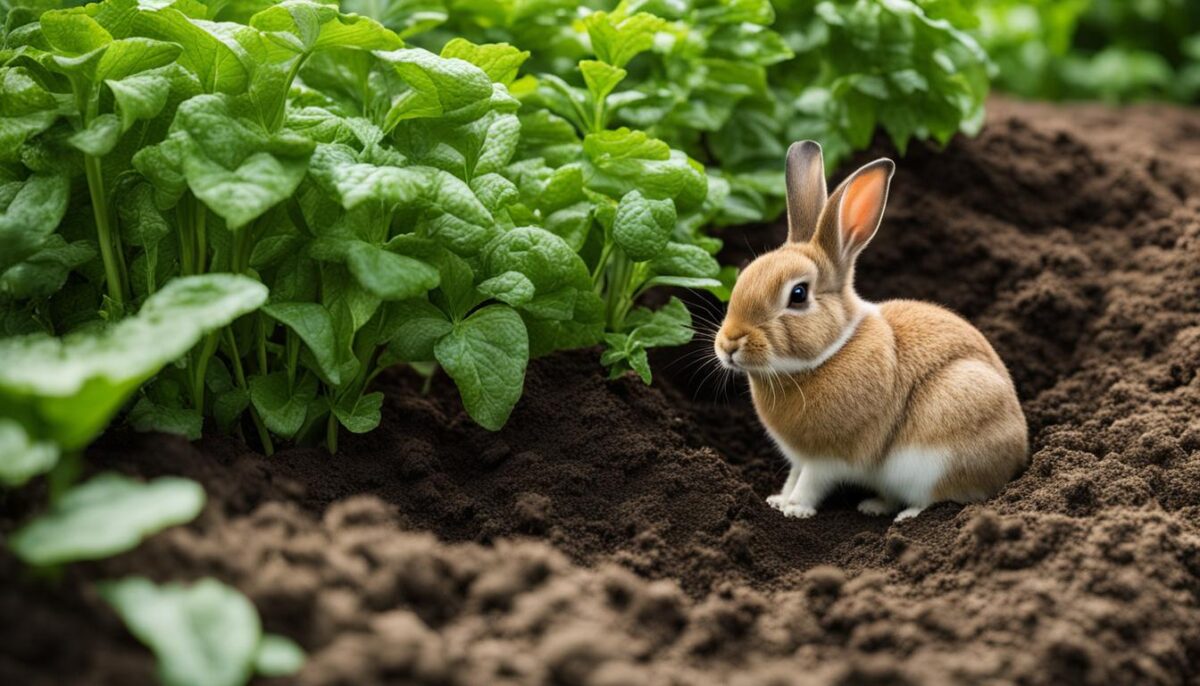
Benefits of Using Rabbit Poop as Fertilizer
- High nitrogen content promotes lush, green foliage.
- Enhances soil structure and fertility.
- Increases microbial activity in the soil.
- Reduces the need for synthetic fertilizers.
- Improves moisture retention in the soil.
“Composting rabbit poop not only helps break it down but also prevents any potential transmission of harmful bacteria or parasites.”
Using rabbit poop as fertilizer offers numerous benefits for both your plants and the environment. By utilizing this natural resource, you can reduce your reliance on synthetic fertilizers, minimize chemical runoff, and support sustainable gardening practices.
Conclusion
Being able to distinguish between deer and rabbit poop is essential for various outdoor activities, such as animal tracking and understanding wildlife signs. By carefully observing the appearance, size, color, texture, quantity, location, odor, composition, nutrient content, and environmental impact of the droppings, you can accurately identify which animal is responsible.
The differences in appearance between deer and rabbit poop are evident in their shape and size. Rabbit droppings are small, round pellets, while deer droppings appear as oval-shaped clumps.
Color and texture also play a role in distinguishing between the two. Rabbit droppings are typically brown or black, with a smooth surface and shiny coating. On the other hand, deer droppings are dark brown or black, and their rough surface may contain remnants of plant material, providing insights into their feeding habits.
Understanding how the droppings are distributed can be helpful in identifying the animals’ behavior and habitat preferences. Rabbit droppings are often found in clusters near burrows, gardens, or lawns, while deer droppings are scattered in smaller quantities near wooded areas or trails where deer frequently roam.
The distinct odors emitted by rabbit and deer droppings are another clue in distinguishing between the two. Rabbit poop has a mild, earthy scent, while deer droppings have a pungent, musky odor.
Although both types of droppings contribute to the ecosystem by providing nutrients to the soil and vegetation, rabbit poop is high in nitrogen, making it an excellent natural fertilizer for gardens. Composting the droppings before use ensures proper decomposition and nutrient release.
By understanding these distinguishing factors, you’ll be equipped with the knowledge to accurately identify deer and rabbit poop, allowing you to gain valuable insights into the animals’ habits, preferences, and the role they play in the environment.
FAQ
What are the differences between deer and rabbit poop?
Deer poop is oval-shaped clumps, while rabbit poop is small, round pellets.
How can I differentiate the color of deer and rabbit droppings?
Deer droppings are dark brown or black, while rabbit droppings are typically brown or black, with a golden tint if the rabbit has a diet rich in dried grass and hay.
What is the texture of deer and rabbit poop?
Rabbit droppings have a smooth surface with a shiny coating, while deer droppings have a rough surface, often containing remnants of plant material.
Are there differences in the quantity of deer and rabbit droppings?
Rabbit droppings are usually found in groups or clusters, while deer droppings are scattered in small quantities.
Where can I typically find deer and rabbit poop?
Rabbit droppings are commonly found near rabbit burrows, gardens, or lawns, while deer droppings are often found near wooded areas or trails.
How can I distinguish the odor of deer and rabbit droppings?
Rabbit droppings emit a mild, earthy scent, while deer droppings have a pungent, musky odor.
What is the composition of deer and rabbit poop?
Rabbit droppings consist mainly of plant material, while deer droppings contain both plant material and browse (woody plant parts).
Are there differences in the nutrient content of deer and rabbit droppings?
Rabbit droppings are relatively high in nitrogen, while deer droppings provide essential nutrients for soil and vegetation growth.
How do deer and rabbit droppings impact the environment?
Both deer and rabbit droppings contribute to the ecosystem by providing nutrients to the soil and vegetation, promoting healthy plant growth and maintaining a balanced ecosystem.
Can I use rabbit poop as fertilizer in my garden?
Yes, rabbit poop is an excellent natural fertilizer for gardens, but it’s recommended to compost the droppings before using them to ensure proper decomposition and nutrient release.


